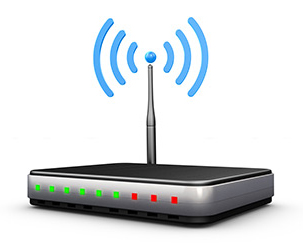Revisit Your Router to Boost Wi-Fi
Is your router outdated? If your home broadband is sketchy—suffering stutters or dropped frames while streaming video or playing online games—the first place to look is your router.

Technology has evolved so quickly and the number of connected devices has increased so dramatically in recent years that it could be time to invest in the hardware at the heart of your home Internet connection. What worked well enough 10 years ago creates an unnecessary bottleneck today if your devices are outpacing your infrastructure.
Smart phones, PCs, tablets, smart TVs and the like are now all competing for your router’s attention on the same radio channels. The mobility, not to mention ubiquity, of these devices has complicated the landscape—including the fact that you may be bumping into your neighbors’ signals.
Older routers were constructed with desktop PCs in mind, supporting high speed at long distances. But now that small mobile devices have taken center stage, router manufacturers have revisited many of this hardware’s fundamental attributes.
A newer router will offer a smarter antenna that can better assemble signals, reduce interference and beam toward devices that move around a lot more than your desktop or laptop did a decade ago. Newer routers can transmit data over two radio frequencies, giving you the option of splitting them up into two separate Wi-fi networks.
The 2.4 GHz band transmits data farther and is more crowded because many types of devices, like cordless phones and microwaves, use that frequency. The 5 GHz band is less congested but typically travels a shorter distance. Mobile devices have made it less important that signal travels far within the home, making the 5 GHz band an attractive option for consumers.
Even on the shorter traveling 5 GHz band, a new router can improve both the speed and range of your broadband. It is likely to have upgraded internal components and a stronger external antenna. It will also support the very latest Wi-fi standards. The latest standard is 802.11ac, topping out at speeds nearly three times the previous standard, 802.11n.
In a recent series of tests from the product recommendations website The Wirecutter, devices had 19 to 54% faster download speeds and 3 to 48% faster file transfers when paired with a new 802.11ac standardized router than with a 802.11n router.
Because people tend to upgrade smart phones and similar devices every three to four years, upgrade to a new router in about this same time frame. But whether your phones, computers and tablets are brand new or up to five years old, now is a good time to buy a new router because newer devices are probably using the 802.11ac standard, so you will get the fastest speeds at long distances with an 802.11ac router. Many people are still using the router their ISP lent them years ago. If your current router is three or more years old, certainly invest in a newer, faster router.
Once you’ve updated your hardware, let the PC optimization software System Mechanic take your broadband speed and stability to the next level. Within System Mechanic, the recently re-architected NetBooster tool will optimize your broadband with a series of diagnostic tests and appropriate micro-adjustments to the Windows OS. There are over a dozen settings hidden to users that default to less than perfect performance when it comes to downloading, streaming and gaming. In addition, NetBooster will automatically seek out the very fastest DNS server in your neighborhood and allow you to simply click to connect to it.
This triple approach to broadband optimization—upgrading hardware, fine tuning the operating system, and examining connectivity to servers in your area—will ensure that you enjoy the very fastest broadband your home network supports.








